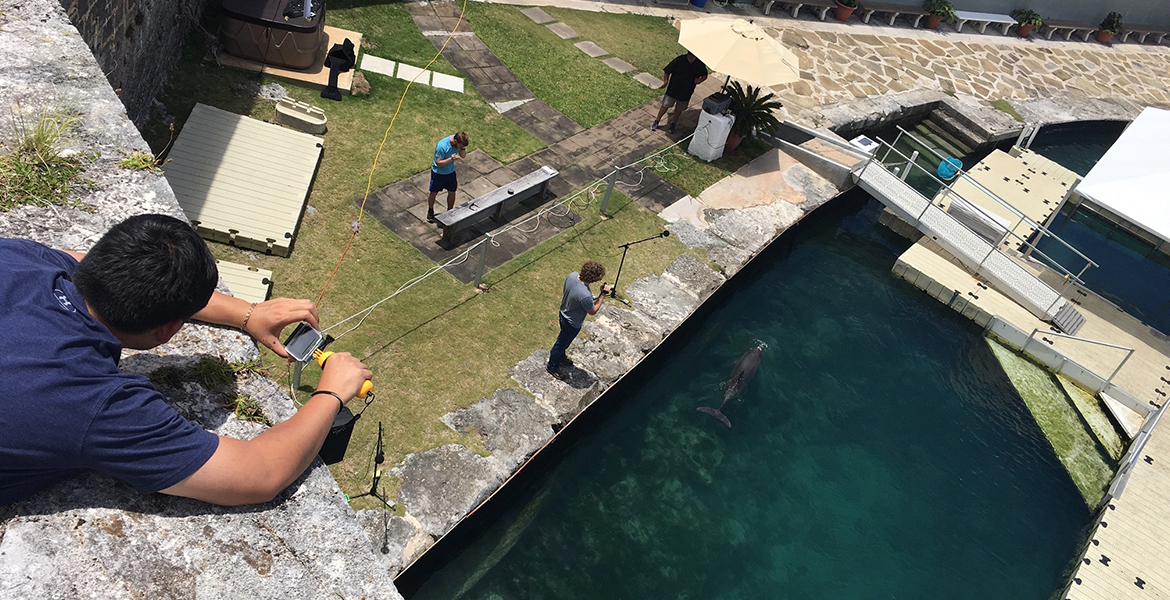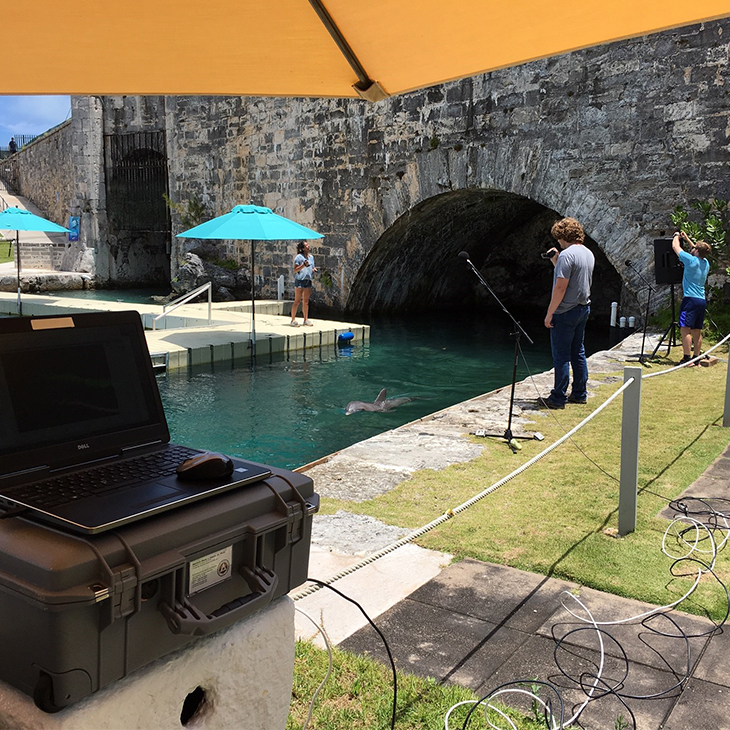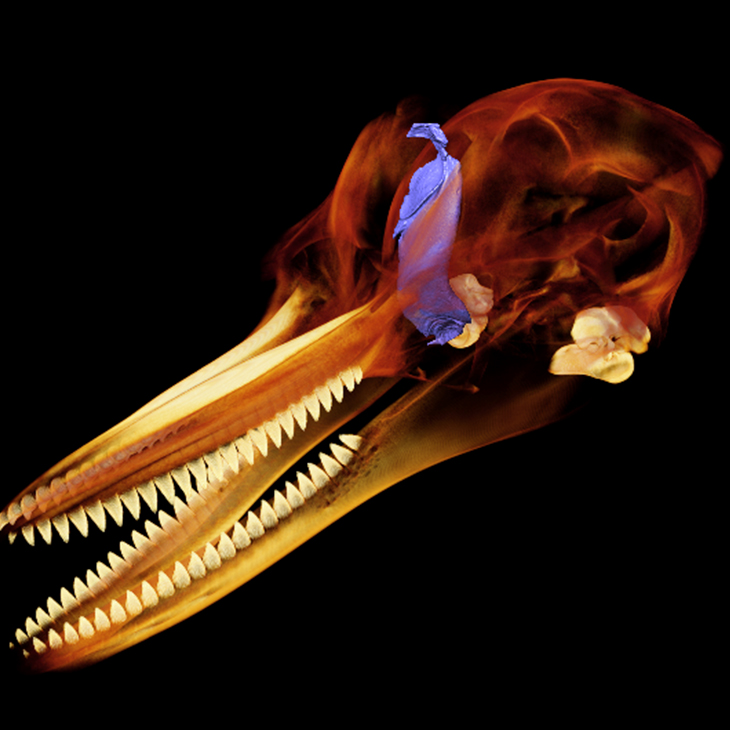
A dolphin project...in Oklahoma!
Friday, October 11, 2019
Given Oklahoma’s notoriously unpredictable weather, it might be no surprise that the Unmanned Systems Research Institute at Oklahoma State University is working with climate experts to improve forecasting. But it might be a surprise to learn that the institute and other researchers in OSU’s College of Engineering, Architecture and Technology and its College of Arts and Sciences (CAS) are playing a role in research on dolphins.
Assistant professor Rick Gaeta of the School of Mechanical and Aerospace Engineering; associate professor Aaron Alexander of the Division of Engineering Technology; professor Jamey Jacob, director of the Unmanned Systems Research Institute; and teaching assistant professor Jason Bruck of Integrative Biology in CAS are teaming up to find ways to measure stress and health in wild dolphins affected by human disturbance. “The overall research objective is to be able to understand, capture and measure dolphins’ stress levels in a wild environment that are due to a variety of things,” Gaeta said. “But most importantly, human-made factors in the ocean such as industrial oil extraction, shipping noises, military sonar and other sounds can affect their stress levels.”
Researchers can measure stress by analyzing the hormone cortisol, which dolphins —
like all mammals — have. “The trick is how do you actually collect this cortisol on
a dolphin in the wild without causing it more undue stress?” Gaeta said.
Dolphins breathe from a blowhole, and each breath is much like a person’s sneeze,
laden with fluids.
Collecting this dolphin snot is equivalent to a mucus or saliva sample taken from a human patient. Taking a blowhole sample from a dolphin in the ocean is quite a challenge. That’s where Gaeta’s and Jacob’s expertise with unmanned aerial vehicles (drones) comes in.
Drones have captured cortisol samples from large whales, which are much slower and generally not spooked by a buzzing drone. However, dolphins are more agile and more likely to react negatively to the buzzing sounds of a drone. The challenge becomes designing a quiet drone that will not scare the dolphins.

Dr. Jason Bruck, a dolphin researcher from OSU’s Department of Integrative Biology, explains: “Using controlled experiments with dolphins under human care and the introduction of differing drone sounds above water played from a speaker, we are looking for things like how long the animal spends under water as a measure for how well they can hear the devices. We are also looking for things like how long they pair up, which is basically a sign that they need to regroup and swim together. We look at all those types of behavior as indicators that the animals are not only perceiving the drone sounds, but they are also reacting to it.”
Gaeta adds that not all drones sound alike. Some sound like “a swarm of bees” due to small high-speed rotors while others can sound more like a large fan. Also, whether the drone is a multirotor vehicle or a fixed-wing aircraft with a single propeller can make a big difference in the sound. Another challenge to successful hormone collection involves defining the dolphin’s vision. Even if a drone is quiet, a dolphin may still see it approaching and take evasive maneuvers.
“The other thing we are working on is defining the visual field of the dolphin,” Bruck
said. “We do not know where the dolphin’s blind spots are. They have eyes on the opposite
sides of their heads, and we think they are pretty good at seeing things from the
sides, but we hypothesize that they have a blind spot above their heads based on behavioral
anecdotes taken from those who work with
dolphins on a daily basis. However, we have never systematically studied that, so
this is one of the things we are studying this summer in Bermuda at our partner facility
Dolphin Quest. We will be looking at where the blind spots of the dolphin are so we
can position collection devices where we want them without startling the animal.”
Gaeta is trying to understand the dolphin’s respiration rate. A dolphin’s very fast 0.3-second natural inhale/exhale breathing mechanism can be extrapolated to the engineering principal of jet dynamics. Specifically, dolphin breath looks like a two-phase jet exhaust or a combination of air and a saliva/seawater mixture. To help model the dolphin’s breath, Alexander will use his computational expertise to model the dolphin breath with Computational Fluid Dynamics, which will be used to compare and extend Particle Imagery Velocimetry measurements made in Jacob’s lab.
The models will allow the researchers to examine how the breath plume is affected by the dolphin swimming at 20 mph. In order to accurately model the dolphin breath plume, it is critical to use the actual anatomical geometry.
Dr. Haley O’Brien, assistant professor in the Department of Anatomy and Cell Biology
at OSU’s Center for Health Sciences, has created a three-dimensional scan of the internal
anatomy of an actual dolphin head. By using cutting-edge microCT technology, O’Brien
captures X-ray images that let the team peer into dolphin anatomy with a degree of
magnification finer than a human
hair, providing the highest precision model of dolphin anatomy.

\Before this collection can be attempted in wild animals that are protected by both federal and international regulations, it must first be proven safe for the dolphins. That’s why Gaeta and Jacob, along with mechanical engineering undergraduate students have designed a static piston-based mechanical simulator to replicate a dolphin’s respiratory system.
Replicating the size and velocity of expectorant from the blowhole brings the biology side into play with Bruck, in cooperation with the OSU Collection of Vertebrates and its animal samples, providing estimated blowhole exit velocity data of 73 feet per second.
In other words, a quiet drone will eventually have to track down a dolphin traveling 20 mph, with a goal of catching its blowhole exhalation sample while the exhaling lasts for all of about 0.3 seconds.
Not only must the researchers figure out how to get the samples from the dolphins — they have yet to know how big of a sample they need to get the needed concentrations of cortisol.
“What is the minimal concentration of cortisol needed to determine where the drone
needs to be positioned to collect the appropriate amount of dolphin mucus?” Gaeta
said. “Is that a foot above, 10 feet above? Is it only in the first inch above the
water? How big is the sample? How quickly does it dissipate? Data from captive dolphins,
which will lead to accurate modeling and simulation, will help
answer these questions. All these variables are going to define the concept of operation
and design of this specialized drone.”
“I think the takeaway from this is it is an interdisciplinary collaboration,” Jacob said. “There are CEAT undergraduate senior design students working on components that will be used in research by graduate students. It expands not only in different areas, but also on different research levels. This is the kind of multidisciplinary activity USRI was designed specifically to support.”
Gaeta draws an even bigger picture: “You can also look at this project as a subset of a larger research area that focuses on the interaction of drones and the animal kingdom. As humans, we are just now dealing with the impact of how drones affect our daily lives. This will happen with drones and animals, as well. Drone interactions with livestock or birds will become more important. OSU has strong research programs in both unmanned aerial systems and animal behavior that make it uniquely qualified to be a leader in this field. This will be part of a larger story.”
